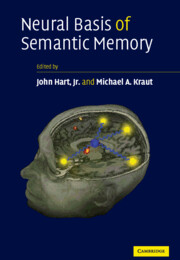Book contents
- Frontmatter
- Contents
- List of contributors
- Preface
- Part I Semantic Memory: Building Models from Lesions
- Part II Insights from Electrophysiology
- Part III Applications of Models to Understanding Cognitive Dysfunction
- Part IV Representations of Nouns and Verbs vs. Objects and Actions
- Part V Critical Role of Subcortical Nuclei in Semantic Functions
- Part VI Conceptual Models of Semantics
- Part 10 Process and content in semantic memory
- 11 The conceptual structure account: A cognitive model of semantic memory and its neural instantiation
- 12 Neural foundations for conceptual representations: Evidence from functional brain imaging
- 13 Neural hybrid model of semantic object memory (version 1.1)
- Index
- References
Part 10 - Process and content in semantic memory
from Part VI - Conceptual Models of Semantics
Published online by Cambridge University Press: 14 September 2009
- Frontmatter
- Contents
- List of contributors
- Preface
- Part I Semantic Memory: Building Models from Lesions
- Part II Insights from Electrophysiology
- Part III Applications of Models to Understanding Cognitive Dysfunction
- Part IV Representations of Nouns and Verbs vs. Objects and Actions
- Part V Critical Role of Subcortical Nuclei in Semantic Functions
- Part VI Conceptual Models of Semantics
- Part 10 Process and content in semantic memory
- 11 The conceptual structure account: A cognitive model of semantic memory and its neural instantiation
- 12 Neural foundations for conceptual representations: Evidence from functional brain imaging
- 13 Neural hybrid model of semantic object memory (version 1.1)
- Index
- References
Summary
To identify something is to group it with like objects called by the same name; that is, to place it in a category. This process begins in our earliest days of acquiring language: the toddler who learns that his spherical rubber toy is a “ball” will spontaneously use that same word for striped beach balls and fuzzy tennis balls. Categorization allows us to make assumptions about an object at hand based on experience with related ones; without this capacity we would be first-time visitors to our own planet with every new experience, unable to understand our surroundings. Hence categorization is essential to the organization of semantic memory, that is, our long-term representation of meaningful non-episodic information.
How does categorization take place? Semantic content knowledge (e.g. appearance, specific features, and functions) and ability to process that knowledge (e.g. select appropriate features and make comparisons) are both necessary. Consider this scenario: someone describes a 45-year-old female traffic cop who strictly disciplines her grandchild as “not what one usually thinks of as a grandmother.” Presumably the speaker is referring to characteristics commonly associated with grandmothers, e.g. being elderly, sedentary, sweet-natured, and eager to spoil their grandchildren. Of course, the speaker also knows that what qualifies someone as a grandmother is being a mother of a parent, age, appearance, and lifestyle notwithstanding. This scenario illustrates two primary categorization processes: similarity-based and rule-based (Smith et al., 1998).
Keywords
- Type
- Chapter
- Information
- Neural Basis of Semantic Memory , pp. 247 - 264Publisher: Cambridge University PressPrint publication year: 2007
References
- 10
- Cited by



